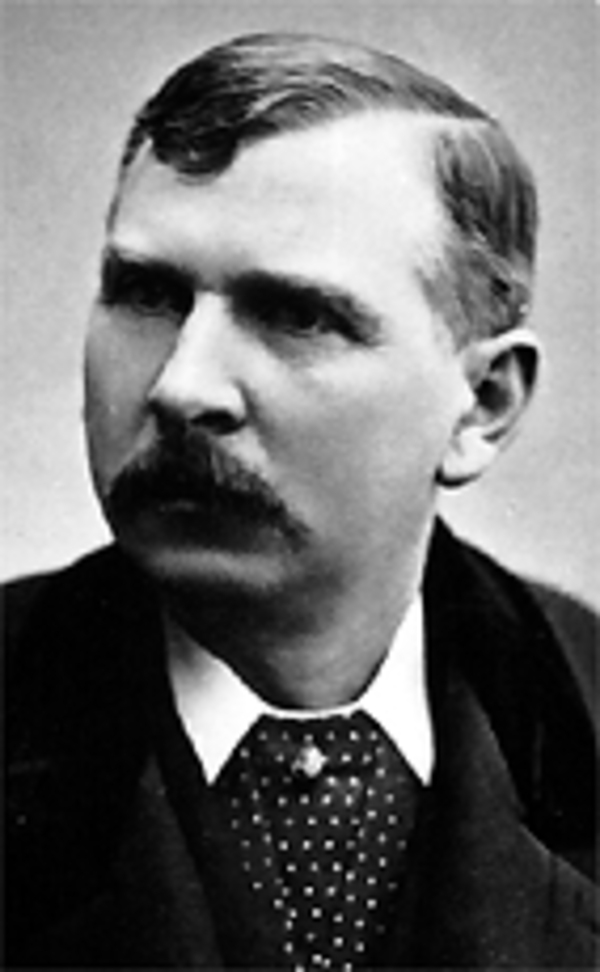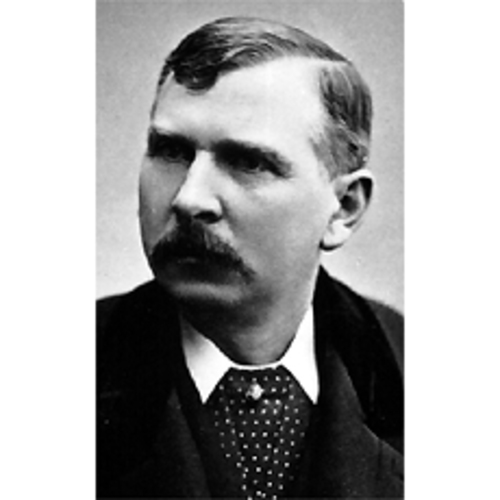
Source: Courtesy of Wikimedia Commons
BURNS, KENNEDY FRANCIS, businessman and politician; b. 8 Jan. 1842 in Thomastown (Republic of Ireland), son of Thomas E. Burns and Ann Ryan; m. 26 Sept. 1865 Harriet McKenna in Bathurst, N.B., and they had four daughters; d. there 23 June 1895.
After attending school in his home town, Kennedy Francis Burns emigrated to British North America; he studied at St Mary’s College in Halifax and then in Saint John, N.B. In 1857 he became a clerk at Chatham, with the firm of John Burke, general merchant. Sent to work at Bathurst in 1861, he bought his employer’s store there two years later and went on his own. He continued in this business until 1874, when he acquired some land on the Caraquet River in Gloucester County for $1,000. The presence on the property of a water-operated sawmill led to Burns’s involvement in the export of lumber, and the formation of K. F. Burns and Company. In 1878 he took his brother Patrick and his brother-in-law Samuel Adams into partnership with him, establishing Burns, Adams and Company. They built a steam-powered sawmill in Bathurst which went into production in the spring of 1880. With a capacity of 60,000 board feet per day, this mill was one of the most important industries in the town for several decades. Adams left the company in 1880 and its name reverted to K. F. Burns and Company. From 1877 to 1885 lumber from the water-operated mill was exported to Great Britain from Caraquet, the amount varying from 2,500,000 to 4,500,000 board feet per year. During this period the steam-mill produced about double these quantities and exported them from Bathurst. After the Caraquet Railway was opened in 1885, all the lumber was shipped from Bathurst. In 1890 Burns founded the St Lawrence Lumber Company, of which he was president. This firm owned a mill at Bersimis (Betsiamites), Que., as well as the facilities established by Burns in New Brunswick. It was financed by British capital, and when the London firm of Novelli went bankrupt in 1894, the St Lawrence Lumber Company collapsed. Burns’s brother and brother-in-law bought back its assets the following year.
Once he had opened his first sawmill, Burns also became heavily involved in the Caraquet Railway Company, set up in 1874 to build a link between Bathurst and the Acadian peninsula of northern New Brunswick. The company’s major stockholder and its president in 1882, Burns obtained grants from the federal and provincial governments for the construction of the line. The first section, between Bathurst and Caraquet, was opened in the autumn of 1885. It quickly became apparent that the railway existed chiefly to serve Burns’s interests. The line made a 13-mile detour to reach his sawmill, trains ran mainly in the summer when the mills were in operation, and service was frequently irregular in the winter. In 1889 there was a major scandal when the English stockholders accused Burns of fraudulent schemes and false representation in regard to the construction and the issuing of shares. Throughout his career as a businessman, Burns mainly used Acadian workers; he paid his employees with due-bills, which could be exchanged only at the company store. He was the beneficiary of governmental largesse in the form of railroad subsidies and cutting licences for timber on New Brunswick crown lands.
The year 1874 also marked Burns’s entry into politics: he was elected to the province’s House of Assembly for Gloucester. His term proved eventful. As a Roman Catholic, he opposed the Common Schools Act of 1871 since it deprived his co-religionists of the educational rights they had previously enjoyed by virtue of custom, if not by law. He was involved with the defence fund set up for the Acadians who had been charged following the Caraquet riot of 1875, in which an opponent of the act and a member of the hastily constituted militia were killed [see Samuel Robert Thomson*]. Burns left provincial politics in 1878. Four years later, he was elected to the House of Commons for Gloucester, defeating Timothy Warren Anglin of Saint John, and he was re-elected in 1887 and 1891. In Ottawa, Burns became an ardent champion of Sir John A. Macdonald’s National Policy. He still had to defend himself, however, against the accusations that Edward Blake* levelled in connection with the Caraquet Railway scandal. In 1894 he was appointed to the Senate. He had aspirations to become lieutenant governor of New Brunswick, but they were never fulfilled.
One of the interesting aspects of Burns’s political career was the fact that although he could not speak French, he secured election in a constituency with a large majority of Acadians. Pascal Poirier*, an Acadian nationalist, maintained that Burns owed his success to Bishop James Rogers* of Chatham, who had great influence over the Acadian voters. On several occasions Burns was accused of fraud and conflict of interest, and the election results were challenged in court. His controversial career came to an end on 23 June 1895, when he died at his home in Bathurst after contracting pneumonia.
Arch. de l’évêché de Bathurst (Bathurst, N.-B.), Sainte-Famille (Bathurst), reg. des baptêmes, mariages et sépultures, vol.6, 26 sept. 1865 (mfm. at PANB). CEA, Fonds Edmé Rameau de Saint-Père, 2.1-30 (Pascal [Poirier] à Rameau de Saint-Père, 27 mai 1894). Gloucester Land Registry Office (Bathurst), Registry books, 23, no.46; 28, nos.35–37; 35, no.365. NA, MG 26, C: 1404–5; RG 31, C1, 1861, Gloucester. PANB, MC 1156, I: 57; MC 1246, II/14/3/1, “J. B. Snowball’s Miramichi Wood Circular,” 1879, 1885. Can., House of Commons, Debates, 1883: 476–81; 1890: 4602–44. Courrier des Provinces Maritimes and Gloucester Chronicle (Bathurst), 10 March 1887, 21 June 1888, 30 April 1891. Miramichi Advance (Chatham, N.B.), 8 Nov. 1877; 21 Feb. 1878; 1 Jan. 1879; 15 May, 23 Dec. 1880; 29 Dec. 1881; 31 Jan. 1884; 22 Jan. 1885. Le Moniteur acadien (Shédiac, N.-B.), 26 nov. 1885, 1 mars 1883. Times (London), 30 March 1889, 10 Feb. 1891. World (Chatham), 17 June 1885. Canadian directory of parl. (Johnson). Dictionnaire biographique du nord-est du Nouveau-Brunswick (4 cahiers parus, [Bertrand; Shippegan, N.-B.], 1983– ), 3: 12–15. A statutory history of the steam and electric railways of Canada, 1836–1937 . . . , comp. Robert Dorman (Ottawa, 1938), 146. Raymond Léger, “L’industrie du bois dans la Péninsule acadienne (N.-B.), 1875–1900” (thèse de ma, univ. de Moncton, N.-B., 1987), 33, 39–68, 73–74. G. F. G. Stanley, “The Caraquet riots of 1875,” Acadiensis (Fredericton), 2 (1972–73), no.1: 36–37.
Cite This Article
Raymond Léger, “BURNS, KENNEDY FRANCIS,” in Dictionary of Canadian Biography, vol. 12, University of Toronto/Université Laval, 2003–, accessed January 1, 2026, https://www.biographi.ca/en/bio/burns_kennedy_francis_12E.html.
The citation above shows the format for footnotes and endnotes according to the Chicago manual of style (16th edition). Information to be used in other citation formats:
| Permalink: | https://www.biographi.ca/en/bio/burns_kennedy_francis_12E.html |
| Author of Article: | Raymond Léger |
| Title of Article: | BURNS, KENNEDY FRANCIS |
| Publication Name: | Dictionary of Canadian Biography, vol. 12 |
| Publisher: | University of Toronto/Université Laval |
| Year of publication: | 1990 |
| Year of revision: | 1990 |
| Access Date: | January 1, 2026 |



